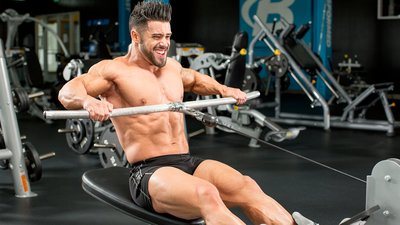When building a bigger back, it makes no difference what your ultimate goal is—your back should have the strength and density to both show and go. This means you have to devote some special attention to training this massive body part.
If your back looms as the weakest part of your game, you need a specialized training program to bring it up to speed. Start by following these four simple rules.
1. Attack Your Weaknesses Head On
The point of addressing a lagging body part is to convert your weaknesses into strengths, and you can't do that by working around them. If you're not good at the deadlift, then don't focus on rack pulls—work on your full deadlift! Add more volume, perform them from a deficit, or work with both sumo and conventional stances until you master this crucial lift.

Deadlifts are key to building a broader back, so if you've been working around this weak exercise, it's time to suck it up and make heavy pulls a big part of your program. The same is true for pull-ups—another commonly skipped exercise. If you want to be wider, you have to do pull-ups, even if it means starting off on the assisted machine. Remember, the goal isn't to massage your ego, it's to make your back look and perform better.
2. Train Back Twice a Week
The back is a big part of your body, so when it lags, it can be a big problem. And you simply can't work on a lagging area once a week and expect it to noticeably improve. To double up on one muscle group, break it down into two parts. One day can be a power day, where you work on big lifts such as the deadlift, barbell rows, one-arm rows, and shrugs for the traps. The other day can be a day of details, focusing on pull-ups, pull-downs, high rows, and pull-overs.
You can also go heavy for low reps on one session, and use the other to increase reps. Whichever workout is more important for your goals is the one you would place first in your training schedule. Regardless, leave at least 72 hours between the workouts to ensure full recovery.
3. Use Full Range of Motion
There are some exercises where you can shortchange the range of motion and still reap benefits. But when training back, full range of motion is essential. You want to engage your back early and make sure you feel the muscle working throughout the entire rep. A full range of motion contraction helps send blood to the muscle and improves detail and separation.

Stretching is also a big part of back training. Getting a good stretch on rows and pulls will help maximize muscle fiber breakdown, so let your muscles move through their full range of motion at both ends of the rep. Here's a hint for most upper-back exercises: If your shoulder blades don't spread apart at full extension, it's not a full rep.
4. Maintain a Mind-Muscle Connection
One issue with back training that doesn't apply with quads, chest, shoulders, or arms is visibility—you simply cannot see the muscle working. As a result, establishing a mind-muscle connection and focusing on the movement is even more important when training back.
When training back, feel the muscles you're trying to target stretch and contract as you move the weight. If you're doing 10 reps, don't think about doing 1 set of 10. Think about doing 10 mini-sets of 1.




